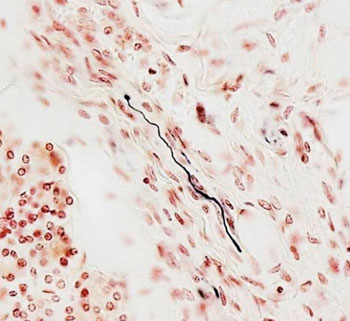Tissue Biomarker Identified For Dementia With Lewy Bodies
By LabMedica International staff writers
Posted on 29 Apr 2016
Accurate diagnosis of Parkinson's disease, and the related disease "dementia with Lewy bodies," can be difficult in the early stages of both conditions. While brain biopsies can be more accurate, the risk of complications has been considered too high.Posted on 29 Apr 2016
A biopsy of the submandibular gland can help identify the same pathology that is seen in the brain, providing some of the increased accuracy of brain biopsy, but not the increased risk. It has previously been reported, from autopsy and needle biopsy, that there is a high prevalence of submandibular gland synucleinopathy in Parkinson’s disease (PD).

Image: Immunostaining: the black fiber is positive for alpha-synuclein pathology inside a nerve fiber in the submandibular gland (Photo courtesy of Journal of Parkinson\'s Disease).
Scientists at Banner Sun Health Research Institute (Sun City, AZ, USA) and their colleagues studied 228 autopsied histological specimens including those with Lewy body disorders included 46 with Parkinson's disease, 28 with dementia with Lewy bodies (DLB), nine with incidental Lewy-body disease, 33 with Alzheimer's disease with Lewy bodies, and two with progressive supranuclear palsy with Lewy bodies (PSPLB). Control subjects, defined as individuals without central-nervous-system Lewy-type synucleinopathy (LTS), included 79 normal elderly subjects, 15 with Alzheimer's disease, 12 with progressive supranuclear palsy, two with corticobasal degeneration and two with multiple system atrophy (MSA).
Submandibular gland sections from autopsied subjects were stained with an immunohistochemical method for α-synuclein phosphorylated at serine 129. The investigators found submandibular gland alpha-synuclein pathology in 42/47 (89%) of autopsies of individuals with Parkinson's disease and 20/28 (71%) of those with dementia with Lewy bodies, but in none of the 110 control subjects. The authors concluded that their results provide support for further clinical trials of in vivo submandibular gland diagnostic biopsy for PD and DLB. An accurate peripheral biopsy diagnosis would assist subject selection for clinical trials and could also be used to verify other biomarkers.
Thomas G. Beach, MD, PhD, the lead investigator said, “The low diagnostic accuracy, during life, for dementia with Lewy bodies, has made it difficult to conduct effective clinical trials of possibly helpful new drugs. With better diagnostic accuracy, clinical trials would have a higher chance of success and could be done more quickly and at lesser cost. The next step will be to do biopsies of the submandibular gland in living people with dementia with Lewy bodies to confirm these autopsy results.” The study was published on March 30, 2016, in the Journal of Parkinson's Disease.
Related Links:
Banner Sun Health Research Institute














